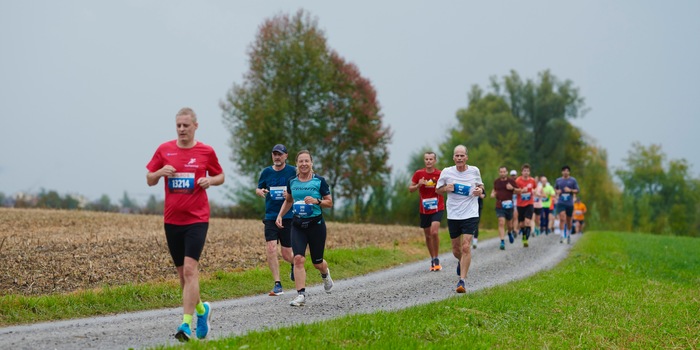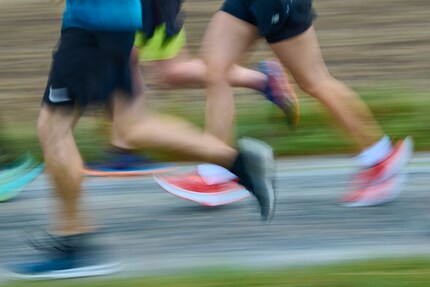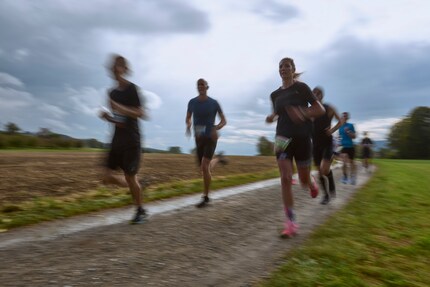
Background information
Five weeks until my half marathon – optimising my diet
by Siri Schubert

I had three goals in running the Lake Hallwil half marathon: to stay uninjured, have fun and finish in under two hours (my time: 1 hour and 53 minutes). Despite being more of a water sports athlete than runner, I achieved all three goals. Here’s what worked in my preparation and what I’d do differently next time.
When I took my place at the starting line of the 49th Lake Hallwil run, I was a bit nervous. But also overjoyed to be surrounded by so many motivated runners. The run itself was a pleasure. The route was beautiful, the atmosphere was good and there was even a live band playing at the Hallwyl Castle (though I could only listen to a few bars as I ran past). A total of 4,495 athletes participated in the different running disciplines. The half marathon was won by David Keller and Petra Eggenschwiler, who already came in first in 2021, with great times of 1:09:43 and 1:24:53.
Next to the hardcore ilk, there were also hobby runners like myself. Twelve weeks prior, I had made the decision to try my hand (or rather, feet!) at a half marathon again after a long break from running. I increased my training volume from 38 to 154 kilometres per month and ran a total of 436 kilometres in my twelve weeks of training. Here are five things I’d do the same way again, and five things I’d do differently.
Subjectively speaking, nutritional counselling has helped me the most – even beyond my running training. I’ve been eating more ever since. Especially more carbohydrates and protein. My recovery and energy during workouts have improved as a result. As my nutritionist specialises in athletes and takes a holistic approach, I’ve also come to appreciate recovery and regeneration more. I’m sure this is one reason why I was able to handle the increase in kilometres ran so well.
In order to stay injury-free with little running experience, I tried to prepare my feet as best I could for the stress of the impact. The Blackboard was very helpful because I could exercise my foot muscles even while working at a standing desk. Another important part of training my feet muscles, tendons and ligaments were the casual running sessions in Xero’s barefoot shoes. My feet kept being confronted with new stimuli which strengthened them.
Improvements in performance are achieved during breaks and not during training. I know how important recovery is – at least in theory. But because I’m so addicted to movement, the rest days proved a challenge. Almost always, I still did a bit of running, biking or paddling. All the more useful were the Blackroll Compression Boots – they made it easier for me to really do nothing at all. I also put them on right after the half marathon. Today, one day later, my legs feel good. I’ve no sign of sore muscles.
The Airofit breath trainer also helped me to recover, especially with its relaxation exercises. Focusing on my breathing signalled to my body and mind that a break was now in order. Thanks to the device and the app, I also felt like I was doing something worthwhile for my well-being.
It’s worth trying out different clothes and shoes to find the ones that really fit, feel great and don’t chafe. I opted for the Nnormal Kerag shoes and the Dynafit Alpine Graphic Sports Bra coupled with the Dynafit Alpine Shirt and the Pro Control Compression Short Tights from Craft. I also wore the Compressport Free Belt Pro running belt. Apart from the shoes, your outfit certainly isn’t decisive for running. But mentally it still helps to have the feeling that your gear is just right.
It’s got to be enjoyable, else I certainly wouldn’t lace up my running shoes in my spare time. What I find even more fun than relatively flat routes is trail running in the mountains. Thanks to Up2peak’s trail running offer, I got to know some beautiful routes in central Switzerland. Ultimately, trail running was the reason I wanted to improve my endurance in the first place, leading me to run a half marathon.

For the Lake Hallwil run, I simply had a look at the training plans offered by Garmin and spontaneously chose one that fit within my twelve-week time frame. I found it very convenient that I could load the plan onto my watch, the Garmin Fenix 6 Pro, in just one click. Every day, I was told how long I should run and at what pace. Here’s the thing: the training plan only relied on pace, not heart rate or muscular fatigue. This was suboptimal, as the load is higher during uphill runs, for example, meaning more recovery must be scheduled. Next time, I’ll be sure to choose a heart-rate-based workout plan, which is also easy to download. And I’ll listen to my gut more if I feel I need more frequent break or a different workout.
A large part of my training consisted of slow runs. With slow runs, my form suffers. Biomechanically, this isn’t ideal; it increases the load on the knees as well as the risk of injury. This isn’t to say there’s no risk of injury with speed training, but too many slow runs with poor running technique increase the risk of injury as well. When preparing for my next run, I’ll incorporate more speed sessions and pay more attention to good running technique.

If you want to run better, you have to run. Of course, once you reach a certain level, you need sport-specific training in order to progress. But as an amateur runner, I’m not at that level – and I never will be. Still, the next time I prepare for a run, I’ll do less running and instead incorporate more forms of training like swimming, biking, or touring on the Me-Mover. This also challenges your cardiovascular system. In addition, I find the variety makes me look forward to the running sessions and keeps me from becoming jaded. Through the different movements, other muscles are addressed, thus strengthening the entire musculoskeletal system. I will also pay more attention to training my core. A strong core improves posture and performance when running.
A YouTube binge-watching session the night before the race (cue the nervousness) wasn’t a good idea at all. Why? Because every YouTuber sounded as if they were the sole voice of truth, yet offered contradicting advice. In some cases, I was fortunate enough to realise after just a few minutes that they’d clearly slept through basic biology lessons in school. But others sounded reasonably convincing, even if their advice proved rather counterproductive for me. The result? Utter confusion. In any case, it led me to question my running preparation at a time when it was too late to change anything anyway. For future runs, I’m staying away from pre-race YouTube watching.
One reason I don’t want to watch pre-race YouTube videos anymore is because of the nutrition they advised. Several videos recommended consuming an energy gel already after the first 20 minutes and then at regular intervals, washing it down with water. So, I packed my running belt with water and gels. But what had worked during my training didn’t work at all during the race. The sweet gels were sticky in my mouth, my attempts to drink had me choking, and after two tries I gave up on the whole thing. With this distance, I really wouldn’t have needed any gels. And I’ll spare myself the half litre of water next time, too.

Next time, I’ll also rely more on my feeling than on general advice when it comes to pacing strategy. I held back in the middle part of the race, suppressing the impulse to run faster. It wasn’t until the last three kilometres that I really amped up the pace. But I crossed the finish line feeling like I still had some energy left. Sure, it’s better than breaking down a few kilometres before the finish, but next time I’ll be bolder to see what I’m capable of.
What will be my next run? I haven’t decided that yet. But I definitely feel a great desire to stand at the starting line again soon and run across beautiful landscapes with motivated people.
Header image: Stefan Munsch
Research diver, outdoor guide and SUP instructor – I love being in, on and around water. Lakes, rivers and the ocean are my playgrounds. For a change of perspective, I look at the world from above while trail running or flying drones.
This is a subjective opinion of the editorial team. It doesn't necessarily reflect the position of the company.
Show all